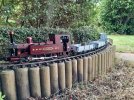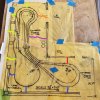I have a 300 ft loop. I run DC. I have two feeds, approx midway around the loop. The cable that runs across the garden between the two feeds is 6.5mm2 cooker cable - so no voltage drop there


All my joints are either Hillman clamps (on LGB flexi track) or Aristo/Bachmann screwed fishplates. That said, LGB flexi is approx 3ft long, so there are less joints. I have approx 150ft of each type of track.
Now, if we think about it, having bisected, roughly, the 300 ft circuit, the elctrickery only has to flow 75 ft before it meets itself again coming from the other feed.
My track-powered locos are Bachmann tender locos with pickups on the tender wheels in addition to the loco wheels.
I had a visit from Neil (Riograndad of this parish) and he brought an LGB Sumpter Valley tender loco - it was only when he ran that loco that I discovered I had a disconnected point blade (the fixed part) on my USAT #6 point, because the LGB loco stalled whereas my Bachmann locos just chuntered across.
However, where the station area has three loops, I only insulate on track, and have ensured that the outside track of the outside loops is not the insulated one, thus the continuity is not compromised through the station loop.
The Bachmann locos don't draw many volts - approx 10 volts when running at a scale 25 - 30 mph, but I do regularly run two Bachmann Connies double headed.
The track had been down approx 8 years, and after last summer's building extension will be reduced to approx 270 ft.
I can only speak from experience







